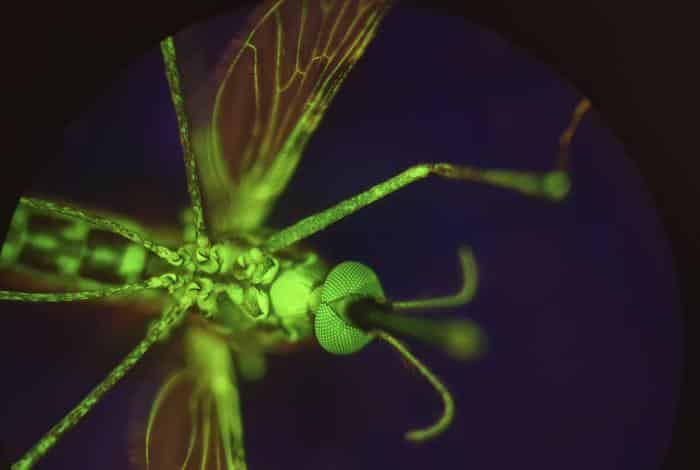

An Anopheles gambiae mosquito that has been fed dye to make her glow. (CREDIT: Provided by Lee R. Haines)
In a nutshell
- A rare disease drug may help fight malaria. Nitisinone, a medication approved for rare genetic conditions, killed malaria-carrying mosquitoes after they fed on treated human blood — offering a surprising new approach to mosquito control.
- It works differently than insecticides. Instead of being sprayed on walls or bed nets, nitisinone turns human blood into mosquito poison, even killing strains that are resistant to conventional insecticides.
- This was a proof-of-concept study using lab-raised mosquitoes and computer models. While the findings are exciting, more testing is needed to confirm safety, cost-effectiveness, and real-world impact.
NOTRE DAME, Ind. — Scientists have stumbled upon an unexpected ally in the fight against malaria: a medication initially created for treating uncommon genetic disorders. A team of international researchers has discovered that nitisinone, a drug approved for treating rare inherited conditions, kills mosquitoes that transmit malaria. A new study reveals how nitisinone makes human blood deadly to mosquitoes by disrupting their ability to process blood meals.
Malaria killed more than 619,000 people in 2021, with most deaths occurring in sub-Saharan Africa. Progress against the disease has stalled as mosquitoes develop resistance to insecticides and malaria parasites evolve to resist treatments. Adding to these challenges, mosquitoes have changed their behavior, avoiding indoor spaces treated with insecticides and feeding more outdoors.
How Nitisinone Turns Human Blood into Mosquito Poison
Research published in Science Translational Medicine found that nitisinone targets a specific enzyme in mosquitoes with an intimidating name (HPPD, for short). This enzyme is crucial for mosquitoes because it helps them break down an amino acid called tyrosine. When mosquitoes can’t break down tyrosine, it builds up to toxic levels.
So what happens when mosquitoes drink blood containing nitisinone? They become paralyzed and die, often within 24 hours. It’s as if they’ve ingested poison.


Unlike traditional insecticides that are sprayed on surfaces, nitisinone works from inside the human body. After a person takes the medication, it circulates in their bloodstream. When a mosquito bites and drinks their blood, it also ingests the drug.
Currently, ivermectin is the only similar drug being tested for malaria control. While ivermectin works, the researchers found nitisinone performed better. Their tests showed that after a three-day treatment course, nitisinone kept killing mosquitoes for about 16 days, compared to just 10 days for ivermectin.
The team tested both young and old mosquitoes of the species that mainly transmits malaria in Africa. Nitisinone killed both age groups effectively. Even better, it also killed mosquitoes that had developed resistance to common insecticides, a huge plus since insecticide resistance is a growing problem.
The study involved real patients. Blood samples from people taking just 2 milligrams of nitisinone daily for a rare condition called alkaptonuria killed mosquitoes when fed to them. This real-world test shows that even small doses might work for mosquito control.
Balancing Potential Benefits with Safety Concerns
Like any medication, nitisinone has both benefits and drawbacks. On the plus side, it’s been used since 1992 and is approved even for newborns and young children. This is better than ivermectin, which isn’t safe for small children or pregnant women.
However, nitisinone causes tyrosine levels to rise in the body, which can lead to eye problems and thinking issues if used long-term. But the researchers believe that for malaria control, people might need smaller doses for shorter periods than those used to treat genetic disorders.
Their calculations show that even a single, small dose might kill mosquitoes for about five days, possibly long enough to make a difference during peak malaria season. Since nitisinone is already approved for human use, it could potentially be deployed for malaria control faster than brand-new drugs.
A New Strategy for Tackling Insecticide Resistance


Mosquitoes are becoming resistant to the insecticides we’ve relied on for decades. It’s like an arms race; we develop new insecticides, and eventually, mosquitoes adapt to survive them.
Nitisinone offers a fresh approach because it works differently than traditional insecticides. Rather than attacking mosquitoes from the outside, it turns their food source, human blood, into something deadly for them.
This drug might be particularly helpful in areas where bed nets and indoor spraying aren’t enough protection, especially in places where mosquitoes have started feeding outdoors more or have developed resistance to common insecticides.
Before nitisinone can be widely used for malaria control, researchers need to figure out the best dosing strategies, make sure it’s safe when given to large numbers of people, and measure its real-world impact in places where malaria is common.
Cost is another challenge. Nitisinone is currently expensive because it’s only used for rare diseases. But if it were to be used more widely for malaria control, the price might come down, making it more accessible for everyone who needs it.
With malaria still killing hundreds of thousands yearly, nitisinone’s mosquito-killing property offers fresh hope. By turning human blood into a deadly trap for mosquitoes, this repurposed drug could become a valuable tool in the ongoing battle against one of the world’s deadliest diseases.
Paper Summary
Methodology
The researchers exposed lab-raised female Anopheles gambiae mosquitoes to blood containing various concentrations of nitisinone or ivermectin. They tracked mosquito survival over 14 days – the time needed for malaria parasites to develop inside mosquitoes to the transmissible stage. They used statistical analysis to determine how much more likely mosquitoes were to die after consuming drug-containing blood compared to normal blood. The team also created mathematical models to predict drug concentrations in human blood over time and tested blood samples from four patients with alkaptonuria (three taking nitisinone, one not) to confirm real-world effectiveness. These experiments were designed as proof-of-concept studies to evaluate the mosquitocidal effect of nitisinone under controlled lab conditions and through pharmacokinetic modeling.
Results
Nitisinone killed mosquitoes rapidly and effectively. When fed blood with nitisinone concentrations equivalent to what would be in a person’s body 7-14 days after a standard dose, most mosquitoes died within 24 hours. The drug remained effective for about 16 days after administration – longer than ivermectin’s 10 days. Both older mosquitoes and insecticide-resistant strains died quickly after consuming nitisinone. Blood from patients taking just 2 mg daily for alkaptonuria killed mosquitoes within 12 hours, even when diluted. Mathematical modeling suggested that even a single dose of 0.1 mg/kg might maintain mosquito-killing activity for about 5 days.
Limitations
The study has several important limitations. Safety concerns exist regarding nitisinone’s side effects, particularly elevated tyrosine levels that can cause eye problems and cognitive issues with long-term use. Lab-raised mosquitoes may not perfectly represent wild populations. The small sample of only four patient blood samples limits confidence in the real-world effectiveness data. Cost remains a significant barrier – nitisinone is currently expensive (approximately $11,000 annually for alkaptonuria treatment), raising questions about affordability in malaria-endemic regions with limited resources.
Discussion and Takeaways
Nitisinone represents a promising new approach to malaria control through a mechanism different from conventional insecticides. Its effectiveness against insecticide-resistant mosquitoes could help address one of the biggest challenges in malaria elimination. The drug might be particularly valuable in areas with residual malaria transmission or where mosquitoes have changed their feeding behaviors. Lower doses than those used for genetic disorders might be sufficient for mosquito control, potentially improving the safety profile. If adopted for malaria control, increased production of nitisinone could potentially lower its cost, benefiting patients with rare genetic disorders who depend on it.
Funding and Disclosures
The research was supported by grants from the UK Medical Research Council, the Biotechnology and Biological Sciences Research Council, the Wellcome Trust, and other organizations. The authors declared no competing interests. The study involved collaboration between multiple institutions, including the Liverpool School of Tropical Medicine, the University of Glasgow, Medicines for Malaria Venture, and the National Alkaptonuria Centre at Royal Liverpool University Hospital.
Publication Information
The study “Anopheles mosquito survival and pharmacokinetic modeling show the mosquitocidal activity of nitisinone” was published in Science Translational Medicine (Volume 17, eadr4827) on March 26, 2025. Lee R. Haines and Anna Trett served as co-first authors, with Álvaro Acosta-Serrano and Ghaith Aljayyoussi as corresponding authors.








